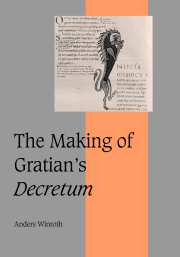
-
Select format
-
- Publisher:
- Cambridge University Press
- Publication date:
- September 2009
- November 2000
- ISBN:
- 9780511496639
- 9780521632645
- 9780521044653
- Dimensions:
- (228 x 152 mm)
- Weight & Pages:
- 0.565kg, 268 Pages
- Dimensions:
- (228 x 152 mm)
- Weight & Pages:
- 0.404kg, 268 Pages
You may already have access via personal or institutional login
Book description
This book offers perspectives on the legal and intellectual developments of the twelfth century. Gratian's collection of Church law, the Decretum, was a key text in these developments. Compiled in around 1140, it remained a fundamental work throughout and beyond the Middle Ages. Until now, the many mysteries surrounding the creation of the Decretum have remained unsolved, thereby hampering exploration of the jurisprudential renaissance of the twelfth century. Professor Winroth has now discovered the original version of the Decretum, which has long lain unnoticed among medieval manuscripts, in a version about half as long as the final text. It is also different from the final version in many respects - for example, with regard to the use of of Roman law sources - enabling a reconsideration of the resurgence of law in the twelfth century.
Awards
Winner of the Samuel and Ronnie Heyman Prize for Outstanding Scholarly Publication 2003
Reviews
'… he deserves credit for not only breathing life into the two-recension theory, but articulating it in such a manner that it will now stand as the thesis to be argued against.'
Source: D'histoire Ecclésiastique
Contents
Metrics
Altmetric attention score
Full text views
Full text views help Loading metrics...
Loading metrics...
* Views captured on Cambridge Core between #date#. This data will be updated every 24 hours.
Usage data cannot currently be displayed.
Accessibility standard: Unknown
Why this information is here
This section outlines the accessibility features of this content - including support for screen readers, full keyboard navigation and high-contrast display options. This may not be relevant for you.
Accessibility Information
Accessibility compliance for the PDF of this book is currently unknown and may be updated in the future.


